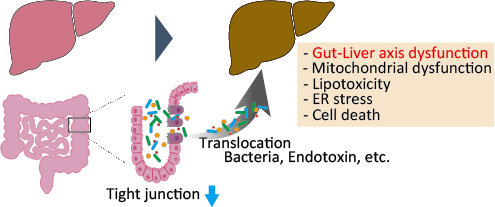Gut Microbiome As a Target For NASH Therapeutics Study
We introduce the development of drugs for Metabolic Dysfunction-Associated Steatohepatitis (MASH) focusing on the gut microbiome and overview of studies using our STAMTM mice.

Currently, the development of treatment and prevention methods for various diseases targeting the gut microbiome is progressing around the world. The relationship between MASH and the gut microbiome, such as increased intestinal permeability and dysbiosis, is getting elucidated [1-3]. For this reason, a microbiome-based therapy approach to treating MASH is gathering attention.
In vivo study of microbiome and MASH using STAMTM mice
Guoxiang et al. reported that in STAMTM mice, changes in the gut microbiome, such as increases in Bacteroides and Clostridium in the gut, occurred, which correlated with increases in blood and liver LPS levels and NAFLD activity score [4]. These changes in the gut microbiome have also been observed in human MASH [5, 6].
Furthermore, Tsumura & Co. (JPN) has reported improved NAFLD activity score and gut microbiota diversity in STAMTM mice treated with Kampo medocone Daisaikoto. And they also discovered that changes in those gut microbiome correlated with MASH pathogenesis in STAMTM mice[7]. These results suggest that a gut microbiota approach to the treatment of MASH is effective.
From the above, the STAMTM mouse is an optimal pathological model mouse for the development of MASH therapeutics focusing on the gut microbiome.
If you have a MASH/MASLD-related drug development or research project focused on gut bacteria, we recommend that you consider in vivo studies using STAMTM mice.
References
1. Zhu L et al., Hepatology. 2013
2. Luther J, et al. Cell Mol Gastroenterol Hepatol. 2015
3. Tsay CJ, et al. Clin Liver Dis (Hoboken). 2022
4. Xie G, et al. Oncotarget. 2016
5. Kolodziejczyk AA, et al. EMBO Mol Med. 2019
6. Sharpton SR, et al. Clin Gastroenterol Hepatol. 2019
7. Ishizawa S et al., Gene. 2022
